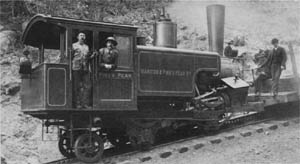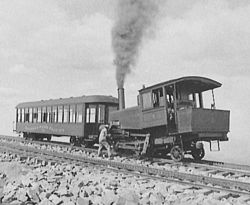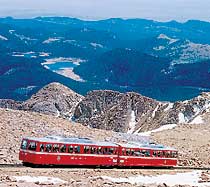Manitou and Pike's Peak Railway
The Manitou and Pike's Peak Railway is an Abt rack system cog railway in Colorado (United States), climbing the well-known mountain Pikes Peak. The base station is in Manitou Springs, Colorado near Colorado Springs. The railway is the highest in North America by a considerable margin. It was built and is operated solely for the tourist trade.
The railway was started by Zalmon Simmons, inventor and founder of the Simmons Beautyrest Mattress Company. The company was founded in 1889 and limited service to the Halfway House Hotel was started in 1890. The summit was reached the following year.
A number of steam locomotives were built for the line by the Baldwin Locomotive Works, all rack-only locomotives with steeply inclined boilers to keep them level on the average 16% grades. Operating steam locomotives on such a line was back-breaking work and expensive, so when more modern forms of traction became available, the railway was eager to modernise.
A gasoline-powered railcar was constructed in 1938, believed to be the first rack railcar in the world. It was designed to be a cheaper alternative to the steam locomotives enabling economic service during quieter times of the year. Proving a huge success, the railway soon bought more internal combustion engined trains. The next were five 'streamlined' diesel locomotives from General Electric, which were equipped with matching passenger cars, acquired from 1940 onward. These slowly supplanted the steam locomotives, though some persisted until the 1960s as backup power and to operate the snow-clearing train (where their greater weight meant they were less likely to derail). A number of the steam locomotives are now on static display, in Manitou and elsewhere.
In 1964 the railway needed more equipment, but General Electric were not interested in the business, so the railway went abroad, to Switzerland, home of the vast majority of the world's cog railways. The Swiss Locomotive and Machine Works in Winterthur provided two bright red railcars, very similar to equipment in use on many Swiss railways. Two more were provided soon afterwards when the first two proved their worth.
With increasing tourism in the 1970s, the railway needed more capacity, and in 1974 took delivery of two larger two-car articulated railcars from the Swiss Locomotive Works. At about the same time, passing sidings were built in several places, allowing trains to pass at various points on the mountainside. Previously, trains could pass only at the Mountain View siding, permitting only three trains a day up the mountain. With the new equipment and sidings, eight trains per day became possible.
As of 2006 the railway owns enough equipment (railcars and snow plows) to run four to six trains per day from mid-May through mid-September. During "off-peak" months (mid-September through mid-December and mid-March through mid-May), up to two trains are run per day, with a third train added if there is sufficient demand. The railway was generally closed from mid-December through mid-March unless the snow plows were able to clear the line; however, in 2006, the railway will begin year-round service.
See also
- Mount Washington Cog Railway - currently the only other cog railway in the United States
- Heritage railway
- List of heritage railways



